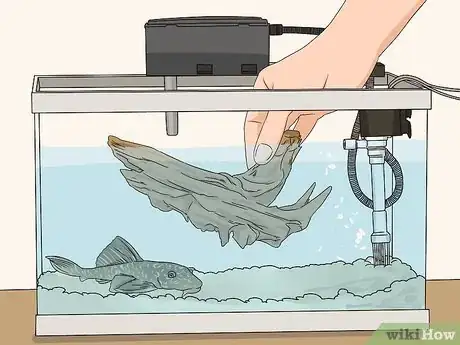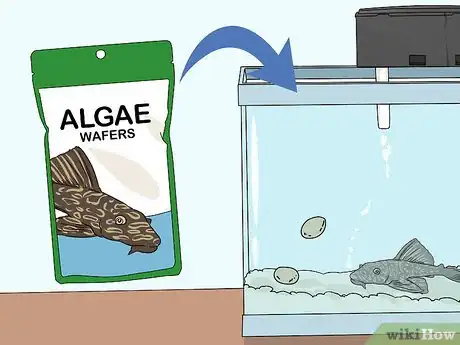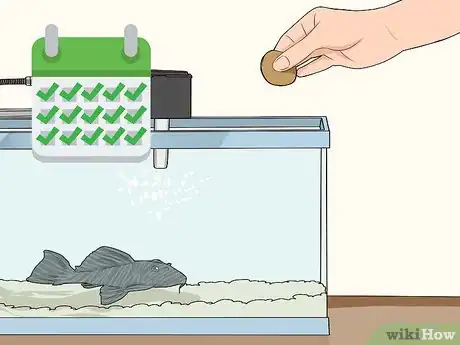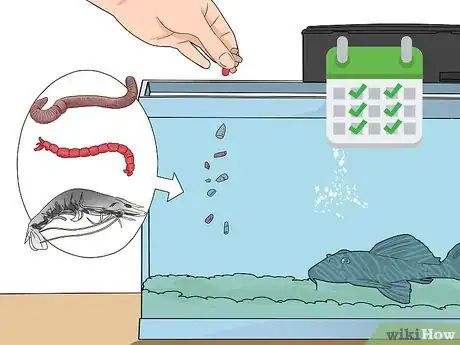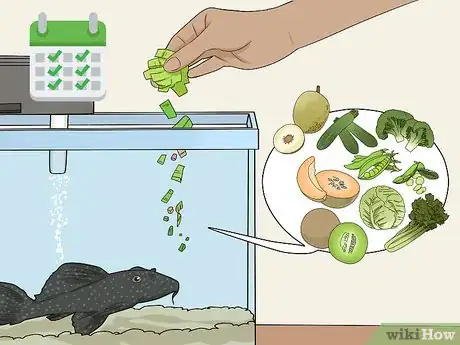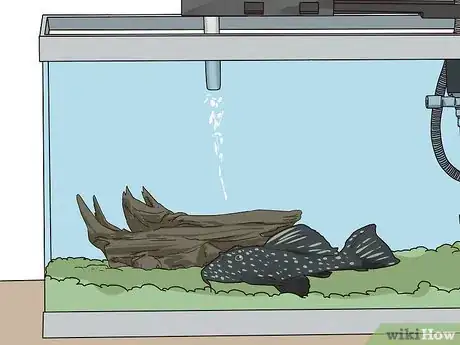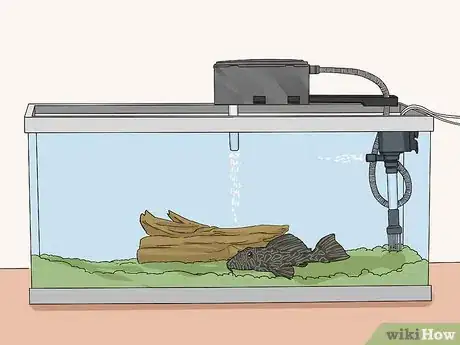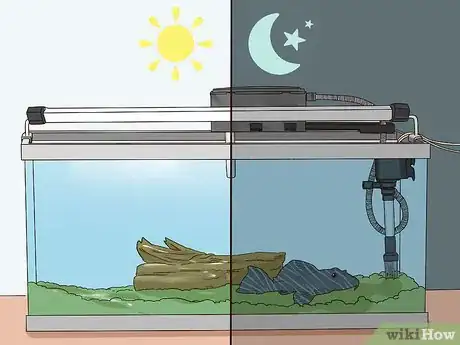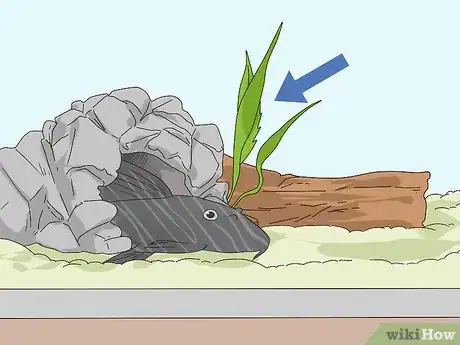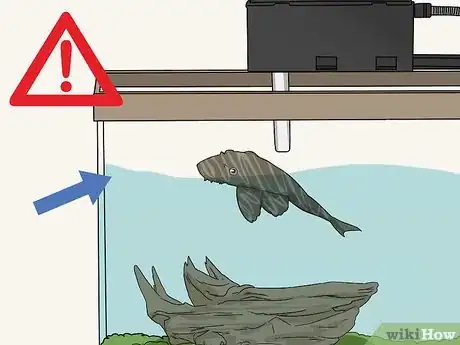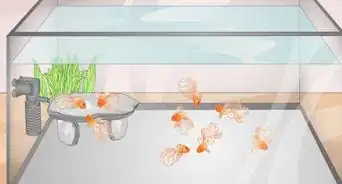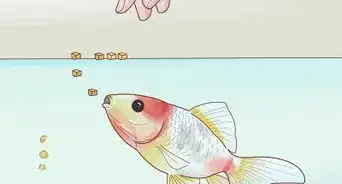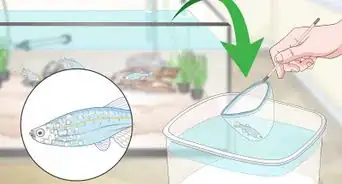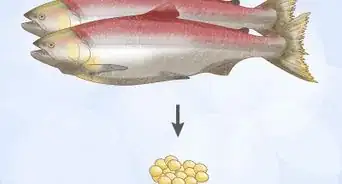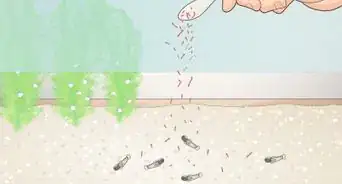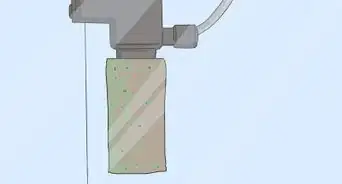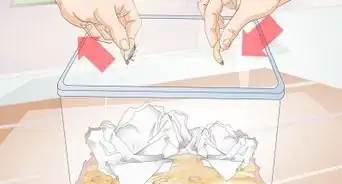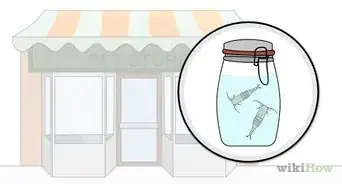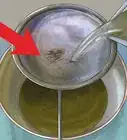This article was co-authored by wikiHow staff writer, Sophia Latorre. Sophia Latorre is a Content Manager on the wikiHow team. Before joining wikiHow, Sophia worked as a technical editor and was published in six International Energy Agency (IEA) Wind Annual Reports. Now, she writes, edits, and reviews articles for the wikiHow Content Team, working to make the content as helpful as possible for readers worldwide. Sophia holds a BA in English from Colorado State University.
There are 9 references cited in this article, which can be found at the bottom of the page.
wikiHow marks an article as reader-approved once it receives enough positive feedback. In this case, 92% of readers who voted found the article helpful, earning it our reader-approved status.
This article has been viewed 190,556 times.
Learn more...
Plecos are a great addition to your aquarium to help keep it algae-free. The pleco, or plecostomus, is a type of catfish often housed in aquariums. Plecos are algae-eaters, but your home aquarium won’t provide enough algae to keep your pleco full. You’ll need to feed plecos algae wafers too. Plecos are omnivores, so you can also feed them meat, like shrimp and bloodworms, as well as vegetables including zucchini and kale.
Steps
Choosing the Right Food
-
1Keep driftwood in the tank at all times. Your pleco needs lots of fiber in their diet, and they can get it from driftwood. Make sure to provide several pieces of driftwood in the aquarium at all times so your pleco can suck and scrape it off. The tiny pieces of driftwood the pleco eats help with its digestion.[1]
- Rather than collecting driftwood yourself, choose real driftwood sold at fish or aquarium stores to ensure it is safe for your pleco.
-
2Feed your pleco algae wafers. To ensure your pleco has enough algae in its diet, you should supplement the algae in the tank with algae wafers. These wafers sink to the bottom of the tank so that your pleco can find them easily.[2]
- Algae wafers can be found at your local pet shop or aquarium store.
Advertisement -
3Add meat to your pleco’s diet. Plecos are omnivores, meaning they eat plants and animals. Your pleco will enjoy earthworms, bloodworms, and shrimp. You can choose between fresh or frozen varieties.[3]
- Earthworms, bloodworms, and shrimp can be found at pet shops and fish stores.
-
4Feed your pleco fruit and vegetables. Your pleco will enjoy a variety of vegetables, like broccoli, shelled peas, lima beans, kale, celery, cabbage, and zucchini. Though your pleco may enjoy small pieces of cantaloupe, honeydew melon, breadfruit, and papaya, you should avoid providing acidic fruits or veggies, like oranges and tomatoes.[4]
- Simply wash and slice the fruit or veggies into small pieces to prepare them for your pleco.
Picking the Right Feeding Schedule
-
1Consider your pleco’s age and size. If you have a small juvenile pleco, they may be able to get by on the algae in the tank, algae wafers, and scraps left over from feeding other fish. However, if the pleco is the only fish in the tank, it will need to be fed more often. Also, as your pleco matures and grows, it will need more variety in its diet and a larger amount of food.[5]
- Young plecos can subsist on one algae wafer per day.
- Once the pleco grows to 24 inches, it is considered mature.[6]
-
2Observe your pleco after feeding. After you provide food for your pleco, watch and see if your pleco gobbles it down. If your pleco immediately begins to munch on the food, they may be overly hungry and need to be fed more often. If your pleco ignores the food, they may need to be fed less often.[7]
-
3Offer at least one algae wafer per day. Your home aquarium will not provide enough algae to keep your pleco full. Give your pleco an algae wafer at night before you go to bed, as plecos are nocturnal and eat at nighttime. If the wafer has been completely consumed by the time you wake up, you can offer another algae wafer to your pleco in the morning.[8]
-
4Give meat to your pleco once or twice per week. As an omnivore, your pleco will enjoy the occasional meaty treat. Give your pleco earthworms, bloodworms, or shrimp once or twice a week. You can choose from fresh, frozen, or pelleted meats. If using fresh meat, cut them into small pieces before dropping them into the tank.[9]
- Give your pleco a few small cut-up raw shrimp or several shrimp pellets, or one cut-up earthworm or bloodworm as one serving.
-
5Feed your pleco fruit or vegetables once or twice per week. Fruit and veggies will provide your pleco with fiber, which they need to stay healthy. Offer your pleco fruit or vegetables once or twice per week.[10] Cut them up into small pieces before adding them to your tank, and add an aquarium weight so they sink to the bottom of the tank.[11]
- Alternatively, you can use an aquarium clip to attach the food to the side of the tank near the bottom.
- Give your pleco a serving the size of a silver dollar, such as one slice of zucchini or a small piece of broccoli.
Keeping Plecos Healthy
-
1Keep only one pleco in an aquarium. Catfish like plecos often fight each other when placed in the same aquarium. Some even fight to the death, so it’s best to keep only one pleco in an aquarium at a time. Plecos generally do well in a tank with most other types of fish, except for piranhas and oscars.[12]
-
2Provide them with plenty of room. In the aquarium, plecos can grow up to 18 inches (46 cm) long! This means you’ll need an aquarium larger than 100 gallons (380 L). You can choose a smaller species of pleco, like the Golden nugget, Zebra, Clown, or Bristlenose pleco, if you have a tank smaller than 100 gallons (380 L).[13]
- For example, a Clown pleco can live comfortable in a 20-gallon tank.[14]
-
3Set up a regular light schedule. Plecos are nocturnal, so they need darkness to signal it’s time to move around and feed. Therefore, it’s not ideal to keep your aquarium lights on constantly. Set a timer on your aquarium lights to replicate natural light cycles (meaning that the lights are on during the day and off at night).[15]
-
4Place hiding spots in the tank. Hiding places help your pleco feel secure and safe. They will spend much of their time hiding, especially during the day. Put small tunnels or caves designed especially for fish in the aquarium, or use sections of PVC pipe.[16]
-
5Don’t fill the tank all the way up. Avoid filling the tank all the way to the top, as plecos come to the surface to gulp air in order to improve their buoyancy. If the tank is completely filled, they may not be able to get the air they desire, or they may bump their snout on the lid and injure themselves.[17]
-
6Ensure the lid on the tank is secure. Plecos are able to jump out of the water, and if the tank has a loose lid they may be able to escape, potentially injuring or killing themselves. For this reason, you need to make sure the lid on your tank is secure.[18]
Community Q&A
-
QuestionIs it okay for my Pleco to eat fish flake food?
 Community AnswerIt's fine, but it would be best if they also ate some algae, raw vegetables, and meat once in a while.
Community AnswerIt's fine, but it would be best if they also ate some algae, raw vegetables, and meat once in a while. -
QuestionWhy is my Pleco sucking on other fish in my tank?
 Community AnswerThis could differ depending on the breed of Pleco. However, some Pleco will resort to "feeding" on fish when they are not having their nutritional needs met. Some Pleco require protein or meat in their diet. When they are starved of proteins, they will seek this from other inhabitants via their slim coat. Once a Pleco gets a taste of slime coat, it is difficult to transition them back. However, try feeding your Pleco at night time just before the lights go out. It may be that other inhabitants in the tank are eating the food source provided before the Pleco gets its fair share.
Community AnswerThis could differ depending on the breed of Pleco. However, some Pleco will resort to "feeding" on fish when they are not having their nutritional needs met. Some Pleco require protein or meat in their diet. When they are starved of proteins, they will seek this from other inhabitants via their slim coat. Once a Pleco gets a taste of slime coat, it is difficult to transition them back. However, try feeding your Pleco at night time just before the lights go out. It may be that other inhabitants in the tank are eating the food source provided before the Pleco gets its fair share. -
QuestionWhat type of item can I use to attach seaweed in place in my aquarium that will not make a mess for Pleco?
 Titans - Gaming and moreCommunity AnswerAnything sinking will work, such as a marble, and be sure to feed them at night.
Titans - Gaming and moreCommunity AnswerAnything sinking will work, such as a marble, and be sure to feed them at night.
References
- ↑ http://aquariumtidings.com/common-pleco/
- ↑ http://animals.mom.me/food-plecostomus-3858.html
- ↑ http://animals.mom.me/food-plecostomus-3858.html
- ↑ http://aquariumtidings.com/common-pleco/
- ↑ https://www.aquasprouts.com/blogs/everything-aquaponics/aquarium-spotlight-algae-eaters
- ↑ http://animal-world.com/encyclo/fresh/catfish/Plecostomus.php
- ↑ https://www.planetcatfish.com/shanesworld/shanesworld.php?article_id=294
- ↑ http://animals.mom.me/food-plecostomus-3858.html
- ↑ http://animals.mom.me/food-plecostomus-3858.html
- ↑ http://aquariumtidings.com/common-pleco/
- ↑ https://www.planetcatfish.com/shanesworld/shanesworld.php?article_id=294
- ↑ http://plecostomus.org/
- ↑ https://www.fishlore.com/Profiles-Pleco.htm
- ↑ https://www.fishlore.com/aquariummagazine/mar09/clown-pleco.htm
- ↑ http://plecostomus.org/
- ↑ http://plecostomus.org/
- ↑ http://www.aquaticcommunity.com/pleco/common.php
- ↑ http://www.aquaticcommunity.com/pleco/common.php
About This Article
To feed a pleco, put several pieces of driftwood in its tank, which your fish can suck and scrape to get the fiber it needs. Additionally, put at least 1 pleco algae wafer in its tank every day to supplement its algae intake. In order to satisfy its desire for meat, try feeding it a few small cut-up shrimp or 1 cut-up earthworm once or twice a week. You should also give it a silver-dollar size portion of a fruit or vegetable, like cantaloupe or broccoli, once or twice a week to round out its diet. To learn how to establish the best feeding schedule for your pleco, keep reading!
